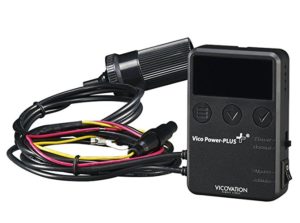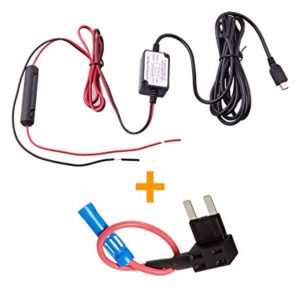Parking Mode Dash Cam Battery Drainage: Dash cam battery drainage are the four dreaded words you never want to hear. More than likely you are readying this because you just purchased a dash cam or are giving serious consideration to purchasing a dash cam that offers a parking mode / parking surveillance option which will sometimes require you to hardwire the dash cam’s power source into your vehicle. As a result you may want to consider buying a battery discharge prevention device. This device is searchable by many names:
- Battery discharge prevention device
- Uninterrupted power cable
- Low battery cutoff
- Battery protector
- Electric power controller
- Power magic

Regardless of you choose to call this device, this little gadget will connect to your dash cam’s power supply and then be hardwired into your vehicle’s battery. The battery discharge device’s main job is to help prevent the discharge (power draining) of the vehicle battery by blocking power to the dash cam if the voltage drops below a certain amount or if a certain amount of time has elapsed. This is key for parking mode or parking surveillance options which allow your car’s dash cam to remain on to detect motion while unattended.
Why is this device necessary?
A lot of people will tell you that a battery discharge prevention device is 100% necessary however this kind of depends on two bits of data. The first factor is how often you actually drive your car. If you happen to be one of those owners who drives their car each day, then a typical dash cam wont really drain enough power from a typical vehicle battery. A lot of people typically leave their vehicles in their driveway (or on the street) for a full weekend in parking mode without any known problems with battery loss. If you happen to know that you are going to be heading out of town for more than a couple of days then it recommend to unplug your dash cam to prevent battery discharge.
The second factor is your vehicles battery’s age. If you have a newer car and/or you installed a new battery battery recently then you are in good shape, the dash cam is unlikely drain the battery for a few days. However, ff your battery is not in decent condition, you will more than likely need to find a replacement for it soon regardless and the reality is that a battery discharge prevention device will only delay the inevitable which means you probably need to replace your battery within a few weeks anyway.

A lot of people know that the cost of a battery is much more than the low cost of these devices, so many people skip the risk all together and just spring for the extra $50-60 bucks and know that their parking mode can be used anytime they wish. Overall, they are a reasonable device to purchase but not 100% necessary depending on your parking behavior and your car’s battery condition.
What is the ideal voltage cut-off?
Unfortunately this is a question that can be answered many different ways. Lead Acid start batteries typically found it most cars should not be routinely deep cycled or that will reduce the life of the battery. However, most people never want to deep cycle their battery and the cutoff probably should be 80% or 90%. Thus, given this info, the voltage cut-off will be around 12.4V. Here is the catch, very few battery protection devices offer this setting. If your battery protection device cut-off is 12V or 12.2V, the battery will deep cycle if it hits this number reducing the life expectancy of the battery.
The table below was created as estimates of the voltage associated with a typical 12V lead acid battery’s charge within a variety of temperatures. Please keep in mind that these voltages are approximate estimates based on an unloaded battery (not when charging) and you can always place a quick call to your dash cams customer service department to be 100% certain.
| Temperature (F) | Temperature (C) | 100% Charge | 75% Charge | 50% Charge | 25% Charge | 0% Charge |
|---|---|---|---|---|---|---|
| 7 | -14 | 12.49 | 12.16 | 11.86 | 11.62 | 11.50 |
| 17 | -8 | 12.51 | 12.18 | 11.88 | 11.64 | 11.52 |
| 27 | -3 | 12.53 | 12.20 | 11.90 | 11.66 | 11.54 |
| 37 | 3 | 12.55 | 12.22 | 11.92 | 11.68 | 11.56 |
| 47 | 8 | 12.57 | 12.24 | 11.94 | 11.70 | 11.58 |
| 57 | 14 | 12.59 | 12.26 | 11.96 | 11.72 | 11.60 |
| 67 | 19 | 12.61 | 12.28 | 11.98 | 11.74 | 11.62 |
| 77 | 25 | 12.63 | 12.30 | 12.00 | 11.76 | 11.64 |
| 87 | 31 | 12.65 | 12.32 | 12.02 | 11.78 | 11.66 |
| 97 | 36 | 12.67 | 12.34 | 12.04 | 11.80 | 11.68 |
| 107 | 42 | 12.69 | 12.36 | 12.06 | 11.82 | 11.70 |
The above chart is important when choosing a device because you want to be sure the voltage “cut-off” is correct for your local temperature. As an example, a voltage “cut-off” of 11.6 is equal to a fully depleted battery when the temp is warmer than 57 degrees Fahrenheit or 14 degrees Celsius. This is really not a good cut-off in most conditions but some devices have this setting or lower.
Parking Mode Dash Cam Battery Drainage // Discount Dash Cam



